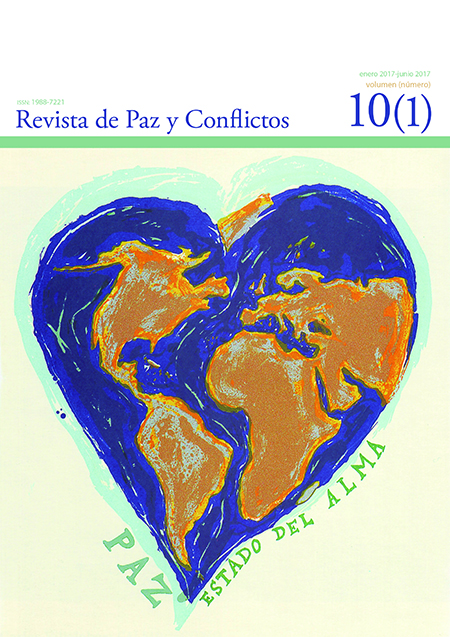A Silenced Conflict: Segregation Processes, Curricular Gaps and Dropout among Spanish Gitanos or Calé
DOI:
https://doi.org/10.30827/revpaz.v10i1.5965Keywords:
Early school leaving, Spanish Romanies, multicultural education, ethnic segregation, ethnic conflict, learning gapAbstract
This paper offers a basic model of some of the main intersecting causes of the early abandonment and school failure of the Gitano or Spanish Romani adolescents. It is based on a long-term research in an educational community where the presence of Romani students has been particularly important. In this research, we studied how professors, parents and students experimented, perceived and voiced the processes that lead to a marked segregation of schools and of Gitano children in school, and how that related to the gradual lag in competences and grades of these children compared to the majority of pupils. One manifestation of this lag is that Gitano children have to repeat courses more often than their non-Gitano partners and become disillusioned and alienated from school routines, become older than their fellow students, thereby increasing conflicts. The problem becomes more severe during the transition from primary to secondary school, which often involves the displacement to an unknown and less protective environment, and a more demanding curriculum. In high school, Gitano pupils keep failing behind, and often become frustrated and discouraged. Around 16 years of age, the limit age of compulsory education, most Gitano adolescents abandon education for good and quickly become adults in hard but gratifying environments where early marriage and labor with kin offers a shortcut to adulthood and independence. Satisfying as this could be in the short term, it did not bode well for the future independence and the sustainable improvement of the living conditions of the Spanish Romani minority.
Downloads
References
Alvarez-Roldan, Arturo, Parra Toro, Iván, y Gamella, Juan F. (en evaluación). The reasons for early school leaving among the Spanish Romani. A mixed methods participatory research study.
Bereményi, Bálint Äbel (2011) Intercultural policies and the contradictory views of teachers: the Roma in Catalonian schools, Intercultural Education, Vol. 22(5), pp. 355–369.
CIS (Centro de Investigaciones Sociológicas) (2006) Escuesta sociológica a hogares de la población gitana, Estudio 2664, Madrid, descargado de http://www.cis.es/cis/opencm/ES/1_encuestas/estudios/ver.jsp?estudio=7820
Colectivo Ioé (2015) Las mujeres gitanas en la Educación Secundaria. Causas de abandono y éxito escolar, descargado de http://www.colectivoioe.org/uploads/221f5ab190f9a9568c25fed3f6190e6e7a1872d8.pdf
Čvorović, Jelena (2004) Sexual and reproductive strategies among Serbian Gypsies, Population and Environment, Vol. 25(3), pp. 217–242.
Čvorović, Jelena (2011) Juvenile marriages, child-brides and infant mortality among Serbian Gypsies, Glasnik Etnografskog Instituta SANU, Vol. 59(2), pp. 27–44.
Danaher, Patrick Alan, Coombes, Phyllida, y Kiddle, Cathy (2007) Teaching traveller children: Maximising learning outcomes, Stoke on Trent, Trentham Books.
ECRI (European Commission against Racism and Intolerance) (2011) ECRI report on Spain, descargado de http://www.coe.int/t/dghl/monitoring/ecri/Country-by-country/Spain/ESP-CBC-IV-2011-004-ENG.pdf
Fernández, Oscar (2006) Educating for difference in a Romany community in Spain: an exercise in integration, Intercultural Education, Vol. 17(4), pp. 373–390.
Fernández Enguita, Mariano (1999) Alumnos gitanos en la escuela paya, Barcelona, Ariel.
Friedman, Victor. A. (1999) The Romani language in the Republic of Macedonia: Status, usage, and sociolinguistic perspectives, Acta Linguistica Hungarica, Vol. 46(3-4), pp. 317–339.
FSG/CIDE/Instituto de la mujer (2006) Incorporación y trayectoria de niñas gitanas en la E.S.O., descargado de https://www.gitanos.org/upload/91/64/1.10-FSG-inc_Incorporacion_y_trayectoria_de_ninas_gitanas_en_la_ESO.pdf
FSG (Fundación Secretariado Gitano) (2013a) El alumnado gitano en secundaria: Un estudio comparado, Madrid, Ministerio de Educación, Cultura y Deporte / Fundación Secretariado Gitano, descargado de: http://gitanos.org/upload/92/20/EstudioSecundaria.pdf
FSG (Fundación Secretariado Gitano) (2013b) El impacto de la crisis en la comunidad gitana, descargado de: https://www.gitanos.org/upload/09/50/el_impacto_de_la_crisis_en_la_comunidad_gitana.pdf
FSGG (Fundación Secretariado General Gitano) (2002) Evaluación de la normalización educativa del alumnado gitano en educación primaria, descargado de https://www.gitanos.org/upload/42/98/completa.pdf
Gamella, Juan F. (1996) La población gitana en Andalucía. Un estudio exploratorio de sus condiciones de vida, Sevilla, Consejería de Trabajo y Asuntos Sociales, Junta de Andalucía.
Gamella, Juan F. (2000) Mujeres gitanas. Matrimonio y género en la cultura gitana de Andalucía, Sevilla, Junta de Andalucía.
Gamella, Juan F. (2011) Historias de éxito. Modelos para reducir el abandono escolar de la adolescencia gitana, Madrid, Ministerio de Educación, descargado de http://www.educatolerancia.com/pdf/Historias de exito_ Modelos para reducir el abandono escolar de la adolescencia gitana.pdf
Gamella, Juan F., Beluschi, Guiuseppe, Gómez Oehler, Elisabeth y Muntean, Vasile (2017) Founder effects and transnational mutations. The familiar structure of a Romani Diaspora, en Matras, Yaron and Leggio, Daniele V. (Eds.) Open borders, unlocked cultures. Romanian Roma migrants in Western Europe, London, Routledge, pp. 83-106.
Gamella, Juan F., Fernández, Cayetano y Adiego, Ignasi-Xavier (2015) The long agony of Hispanoromani. The remains of Caló in the speech of Spanish Gitanos, Romani Studies, Vol. 25(1), pp. 53–93.
Gamella, Juan F., y Martín Carrasco-Muñoz, Elisa (2017) The decline of infant and child mortality among Spanish Gitanos or Calé (1871-2005): A microdemographic study in Andalusia, Demographic Research, Vol. 36(33), pp. 945–988.
Gamella, Juan F., Martín Carrasco-Muñoz, Elisa y Quesada Garrido, Alejandro (2014) New methodological approaches in the Anthropological demography of Romani groups. An example from the study of the evolution of the infant and child mortality of the Gitanos or Calé of Spain (1871-2007) Sociologia, Revista Da Faculdade de Letras Da Universidade Do Porto, Número temático–Ciganos na Península Ibérica e Brasil: estudos e políticas sociais, pp. 175–204.
García Pastor, Begoña (2005) La educación de la infancia gitana en la ciudad de Valencia. Del barrio a la escuela, Tesis Doctoral, Castellón de la Plana, Universitat Jaume I, descargado de http://www.tdx.cat/bitstream/handle/10803/32157/bgarcia.pdf?sequence=1
Giménez Adelantado, Ana; Piasere, Leonardo y Liegeois, Jean Pierre (2002) The education of Gypsy childhood in Europe, Final report, descargado de http://cordis.europa.eu/documents/documentlibrary/82608111EN6.pdf
Harry, Beth (2005) Equity, excellence and diversity in a rural secondary school in Spain: “Integration is very nice , but ….”, European Journal of Special Needs Education, Vol. 20(1), pp. 89–106.
Herzog, Tamar (2003) Defining nations: Immigrants and citizens in early modern Spain and Spanish America, New Haven, CT, Yale University Press.
Ivanov, Andrey et al., (2002) The Roma in Central en Eastern Europe. Avoiding the Dependency Trap, descargado de http://hdr.undp.org/en/content/avoiding-dependency-trap
Kézdi, Gábor y Kertesi, Gábor (2005a) Általános iskolai szegregáció, I. rész. Okok és következmények [La segregación escolar en primaria, parte I. Causas y consecuencias], Közgazdasági Szemle, Vol. 52(4), pp. 317–355, descargado de http://www.kszemle.hu/tartalom/letoltes.php?id=764
Kézdi, Gábor y Kertesi, Gábor (2005b) Általános iskolai szegregáció, II. rész. Az általános iskolai szegregálódás folyamata Magyarországon és az iskolai teljesítménykülönbségek [La segregación escolar en primaria, parte II. Proceso de segregación en la escuela primaria en Hungría y las diferencias en el rendimiento escolar], Közgazdasági Szemle, Vol. 52(5), pp. 462–479, descargado de http://www.kszemle.hu/tartalom/letoltes.php?id=764
La Parra-Casado, Daniel y Jiménez González, Nicolás (Eds.) (2016) Sastipen aj Rroma: Desigualdad en salud y comunidad gitana, Alicante, Universidad de Alicante.
Laparra, Miguel et al., (2011) Diagnóstico social de la comunidad gitana en España. Un análisis contrastado de la Encuesta del CIS a Hogares de Población Gitana 2007, Madrid, Ministerio de Sanidad, Política Social e Igualdad, descargado de http://www.msssi.gob.es/ssi/familiasInfancia/inclusionSocial/poblacionGitana/docs/diagnosticosocial_autores.pdf
Latorre-Arteaga, Sergio; Gil-González, Diana; Vives-Cases, Carmen y La Parra Casado, Daniel (2016) Vision and hearing health inequities in the Roma population: A national cross-sectional study in Spain, Journal of Immigrant and Minority Health, http://doi.org/10.1007/s10903-016-0489-9.
Levinson, Martin P. (2015) “What”s the plan?’ “What plan?” Changing aspirations among Gypsy youngsters, and implications for future cultural identities and group membership, British Journal of Sociology of Education, Vol. 36(8), pp. 1149–1169.
Levinson, Martin P. y Sparkes, Andrew C. (2006) Conflicting value systems: Gypsy females and the home-school interface, Research Papers in Education, Vol. 21(1), pp. 79–97.
Martín, Elisa y Gamella, Juan F. (2005) Marriage practices and ethnic differentiation. The case of Spanish Gypsies (1870-2000), The History of the Family, Vol. 10(1), pp. 45–63.
O’Higgins, Niall (2010) “It’s not that I’m a racist, it’s that they are Roma”, International Journal of Manpower, Vol. 31(2), pp. 163–187.
O’Higgins, Niall y Brüggemann, Christian (2014) The Consequences of Cumulative Discrimination: how special schooling influences employment and wages of Roma in the Czech Republic, European Educational Research Journal, Vol. 13(3), pp. 282-294.
Salinas Catalá, Jesús (2009) Un viaje a través de la historia de la escolarización de las gitanas y gitanos españoles, Anales de Historia Contemporánea, nº 25, pp. 165–188, descargado de http://revistas.um.es/analeshc/article/viewFile/71741/69231
San Román, Teresa (1992) Pluriculturalidad y marginación, en AA.VV., Sobre interculturalidad. Documents de treball de la 2a Escola d’Estiu sobre Interculturalitat de Girona, Girona, Fundació SER.GI, pp. 177-188.
Santiago, Carmen, y Ostalinda, Maya (2012) School segregation of Romani students in Spain, descargado de http://federacionkamira.es/wp-content/uploads/2015/11/School-segregation-report-EN-17-Julio-2012-FINAL-1.pdf
Smith, Tracy (1997) Recognising Difference: the Romani “Gypsy” child socialisation and education process, British Journal of Sociology of Education, Vol. 18(2), pp. 243–256.
Surdu, Mihai (2002) The quality of education in Romanian schools with high percentages of romani pupils, Roma Rights, nº 3–4 (November), descargado de http://www.errc.org/cikk.php?cikk=1628
Downloads
Published
How to Cite
Issue
Section
License
Esta obra está bajo una licencia internacional Creative Commons Atribución 4.0.














